|
 Main Film Genres Main Film Genres
 Main Film Genres: Listed
below are some of the most common and identifiable film genre
categories, with descriptions of each type or category. If
you're interested in the chronological history of film by
decade - visit the section on Film
History - by Decade or the multi-part section on Milestones
in Film History. Main Film Genres: Listed
below are some of the most common and identifiable film genre
categories, with descriptions of each type or category. If
you're interested in the chronological history of film by
decade - visit the section on Film
History - by Decade or the multi-part section on Milestones
in Film History.
|
Genre Types
(represented by icons)
|
Genre Descriptions
|
|
Select an icon or film
genre category below, read about the development and history of the
genre, and view chronological lists of selected, representative greatest
films for each one (with links to detailed descriptions of individual
films).
|

|
 Action
films usually include high energy, big-budget physical stunts
and chases, possibly with rescues, battles, fights, escapes,
destructive crises (floods, explosions, natural disasters, fires,
etc.), non-stop motion, spectacular rhythm and pacing, and adventurous,
often two-dimensional 'good-guy' heroes (or recently, heroines)
battling 'bad guys' - all designed for pure audience escapism.
Includes the James Bond 'fantasy' spy/espionage series, martial
arts films, video-game films, so-called 'blaxploitation' films,
and some superhero films.
(See Superheroes on Film:
History.) A major sub-genre is the disaster
film. See also Greatest
Disaster and Crowd Film Scenes and Greatest
Classic Chase Scenes in Films. Action
films usually include high energy, big-budget physical stunts
and chases, possibly with rescues, battles, fights, escapes,
destructive crises (floods, explosions, natural disasters, fires,
etc.), non-stop motion, spectacular rhythm and pacing, and adventurous,
often two-dimensional 'good-guy' heroes (or recently, heroines)
battling 'bad guys' - all designed for pure audience escapism.
Includes the James Bond 'fantasy' spy/espionage series, martial
arts films, video-game films, so-called 'blaxploitation' films,
and some superhero films.
(See Superheroes on Film:
History.) A major sub-genre is the disaster
film. See also Greatest
Disaster and Crowd Film Scenes and Greatest
Classic Chase Scenes in Films. |
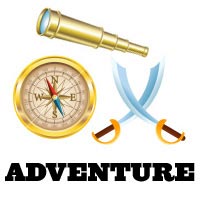
|
 Adventure
films are usually exciting stories, with new experiences or
exotic locales, very similar to or often paired with the action film
genre. They can include traditional swashbucklers or pirate films, serialized
films, and historical spectacles (similar to the epics film
genre), searches or expeditions for lost continents, "jungle"
and "desert" epics, treasure hunts, disaster films, or
searches for the unknown. Adventure
films are usually exciting stories, with new experiences or
exotic locales, very similar to or often paired with the action film
genre. They can include traditional swashbucklers or pirate films, serialized
films, and historical spectacles (similar to the epics film
genre), searches or expeditions for lost continents, "jungle"
and "desert" epics, treasure hunts, disaster films, or
searches for the unknown. |
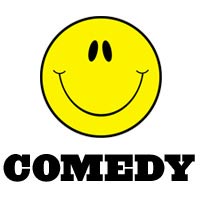
|
 Comedies
are light-hearted plots consistently and deliberately designed
to amuse and provoke laughter (with one-liners, jokes, etc.)
by exaggerating the situation, the language, action, relationships
and characters. This section describes various forms of comedy
through cinematic history, including slapstick, screwball, spoofs and parodies, romantic
comedies, black comedy (dark satirical comedy),
and more. See this site's Funniest
Film Moments and Scenes collection - illustrated, also Premiere
Magazine's 50
Greatest Comedies of All Time, and WGA's 101 Funniest
Screenplays of All Time. Comedies
are light-hearted plots consistently and deliberately designed
to amuse and provoke laughter (with one-liners, jokes, etc.)
by exaggerating the situation, the language, action, relationships
and characters. This section describes various forms of comedy
through cinematic history, including slapstick, screwball, spoofs and parodies, romantic
comedies, black comedy (dark satirical comedy),
and more. See this site's Funniest
Film Moments and Scenes collection - illustrated, also Premiere
Magazine's 50
Greatest Comedies of All Time, and WGA's 101 Funniest
Screenplays of All Time. |
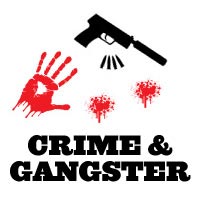
|
 Crime
(gangster) films are developed around the sinister actions of
criminals or mobsters, particularly bankrobbers, underworld
figures, or ruthless hoodlums who operate outside the law, stealing
and murdering their way through life. The criminals or gangsters
are often counteracted by a detective-protagonist with a who-dun-it
plot. Hard-boiled detective films reached their peak during
the 40s and 50s (classic film noir),
although have continued to the present day. Therefore, crime
and gangster films are often categorized as film
noir or detective-mystery films,
and sometimes as courtroom/crime legal thrillers - because of
underlying similarities between these cinematic forms. This
category also includes various 'serial killer' films. Crime
(gangster) films are developed around the sinister actions of
criminals or mobsters, particularly bankrobbers, underworld
figures, or ruthless hoodlums who operate outside the law, stealing
and murdering their way through life. The criminals or gangsters
are often counteracted by a detective-protagonist with a who-dun-it
plot. Hard-boiled detective films reached their peak during
the 40s and 50s (classic film noir),
although have continued to the present day. Therefore, crime
and gangster films are often categorized as film
noir or detective-mystery films,
and sometimes as courtroom/crime legal thrillers - because of
underlying similarities between these cinematic forms. This
category also includes various 'serial killer' films. |
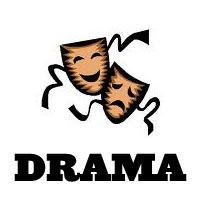
|
 Dramas
are serious, plot-driven presentations, portraying realistic
characters, settings, life situations, and stories involving
intense character development and interaction. Usually, they
are not focused on special-effects, comedy, or action, Dramatic
films are probably the largest film genre, with many subsets.
See also melodramas, epics
(historical dramas),
courtroom dramas, or romantic genres.
Dramatic biographical
films (or "biopics") are a major sub-genre, as
are 'adult' films (with mature subject content). Dramas
are serious, plot-driven presentations, portraying realistic
characters, settings, life situations, and stories involving
intense character development and interaction. Usually, they
are not focused on special-effects, comedy, or action, Dramatic
films are probably the largest film genre, with many subsets.
See also melodramas, epics
(historical dramas),
courtroom dramas, or romantic genres.
Dramatic biographical
films (or "biopics") are a major sub-genre, as
are 'adult' films (with mature subject content). |
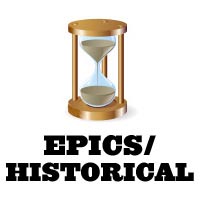
|
 Epics
include costume dramas, historical dramas, war films,
medieval romps, or 'period pictures' that often cover a large
expanse of time set against a vast, panoramic backdrop. Epics
often share elements of the elaborate adventure films
genre. Epics take an historical or imagined event, mythic, legendary,
or heroic figure, and add an extravagant setting or period,
lavish costumes, and accompany everything with grandeur and
spectacle, dramatic scope, high production values, and a sweeping
musical score. Epics are often a more spectacular, lavish version
of a biopic
film.
Some 'sword and sandal' films (Biblical epics or films occuring
during antiquity) qualify as a sub-genre. Epics
include costume dramas, historical dramas, war films,
medieval romps, or 'period pictures' that often cover a large
expanse of time set against a vast, panoramic backdrop. Epics
often share elements of the elaborate adventure films
genre. Epics take an historical or imagined event, mythic, legendary,
or heroic figure, and add an extravagant setting or period,
lavish costumes, and accompany everything with grandeur and
spectacle, dramatic scope, high production values, and a sweeping
musical score. Epics are often a more spectacular, lavish version
of a biopic
film.
Some 'sword and sandal' films (Biblical epics or films occuring
during antiquity) qualify as a sub-genre. |
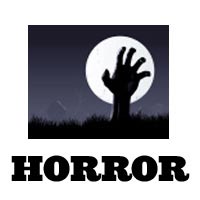
|
 Horror
films are designed to frighten and to invoke our hidden worst
fears, often in a terrifying, shocking finale, while captivating
and entertaining us at the same time in a cathartic experience.
Horror films feature a wide range of styles, from the earliest
silent Nosferatu classic, to today's CGI monsters and deranged
humans. They are often combined with science
fiction when the menace or monster is related to a corruption
of technology, or when Earth is threatened by aliens. The fantasy and supernatural film
genres are not always synonymous with the horror genre. There
are many sub-genres of horror: slasher, splatter, psychological,
survival, teen terror, 'found footage,' serial killers, paranormal/occult,
zombies, Satanic, monsters,
Dracula, Frankenstein, etc. See this site's Scariest
Film Moments and Scenes collection - illustrated. Horror
films are designed to frighten and to invoke our hidden worst
fears, often in a terrifying, shocking finale, while captivating
and entertaining us at the same time in a cathartic experience.
Horror films feature a wide range of styles, from the earliest
silent Nosferatu classic, to today's CGI monsters and deranged
humans. They are often combined with science
fiction when the menace or monster is related to a corruption
of technology, or when Earth is threatened by aliens. The fantasy and supernatural film
genres are not always synonymous with the horror genre. There
are many sub-genres of horror: slasher, splatter, psychological,
survival, teen terror, 'found footage,' serial killers, paranormal/occult,
zombies, Satanic, monsters,
Dracula, Frankenstein, etc. See this site's Scariest
Film Moments and Scenes collection - illustrated. |
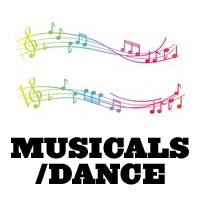
|
 Musical/dance films are
cinematic forms that emphasize full-scale scores or song and dance
routines in a significant way (usually with a musical or dance performance
integrated as part of the film narrative), or they are films that
are centered on combinations of music, dance, song or choreography.
Major subgenres include the musical
comedy or the concert film. See this site's Greatest
Musical Song/Dance Movie Moments and Scenes collection -
illustrated. Musical/dance films are
cinematic forms that emphasize full-scale scores or song and dance
routines in a significant way (usually with a musical or dance performance
integrated as part of the film narrative), or they are films that
are centered on combinations of music, dance, song or choreography.
Major subgenres include the musical
comedy or the concert film. See this site's Greatest
Musical Song/Dance Movie Moments and Scenes collection -
illustrated. |
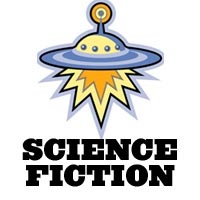
|
 Sci-fi
films are often quasi-scientific, visionary and imaginative
- complete with heroes, aliens, distant planets, impossible
quests, improbable settings, fantastic places, great dark and
shadowy villains, futuristic technology, unknown and unknowable
forces, and extraordinary monsters ('things or creatures from
space'), either created by mad scientists or by nuclear havoc.
They are sometimes an offshoot of the more mystical fantasy films
(or superhero films),
or they share some similarities with action/adventure films.
Science fiction often expresses the potential of technology
to destroy humankind and easily overlaps with horror films,
particularly when technology or alien life forms become malevolent,
as in the "Atomic Age" of sci-fi films in the 1950s.
Science-Fiction sub-categories abound: apocalyptic or dystopic,
space-opera, futuristic noirs, speculative, etc. Sci-fi
films are often quasi-scientific, visionary and imaginative
- complete with heroes, aliens, distant planets, impossible
quests, improbable settings, fantastic places, great dark and
shadowy villains, futuristic technology, unknown and unknowable
forces, and extraordinary monsters ('things or creatures from
space'), either created by mad scientists or by nuclear havoc.
They are sometimes an offshoot of the more mystical fantasy films
(or superhero films),
or they share some similarities with action/adventure films.
Science fiction often expresses the potential of technology
to destroy humankind and easily overlaps with horror films,
particularly when technology or alien life forms become malevolent,
as in the "Atomic Age" of sci-fi films in the 1950s.
Science-Fiction sub-categories abound: apocalyptic or dystopic,
space-opera, futuristic noirs, speculative, etc. |

|
 War
(and anti-war) films acknowledge the horror and heartbreak of
war, letting the actual combat fighting (against nations or
humankind) on land, sea, or in the air provide the primary plot
or background for the action of the film. War films are often
paired with other genres, such as action, adventure, drama, romance, comedy (black), suspense,
and even historical epics and westerns,
and they often take a denunciatory approach toward warfare.
They may include POW tales, stories of military operations,
and training. See this site's Greatest
War Movies (in multiple parts). War
(and anti-war) films acknowledge the horror and heartbreak of
war, letting the actual combat fighting (against nations or
humankind) on land, sea, or in the air provide the primary plot
or background for the action of the film. War films are often
paired with other genres, such as action, adventure, drama, romance, comedy (black), suspense,
and even historical epics and westerns,
and they often take a denunciatory approach toward warfare.
They may include POW tales, stories of military operations,
and training. See this site's Greatest
War Movies (in multiple parts). |

|
 Westerns
are the major defining genre of the American film industry -
a eulogy to the early days of the expansive American frontier.
They are one of the oldest, most enduring genres with very recognizable
plots, elements, and characters (six-guns, horses, dusty towns
and trails, cowboys, Indians, etc.). They have evolved over
time, however, and have often been re-defined, re-invented and
expanded, dismissed, re-discovered, and spoofed. Variations have
included Italian 'spaghetti' westerns, epic westerns, comic westerns,
westerns with outlaws or marshals as the main characters, revenge
westerns, and revisionist westerns. Westerns
are the major defining genre of the American film industry -
a eulogy to the early days of the expansive American frontier.
They are one of the oldest, most enduring genres with very recognizable
plots, elements, and characters (six-guns, horses, dusty towns
and trails, cowboys, Indians, etc.). They have evolved over
time, however, and have often been re-defined, re-invented and
expanded, dismissed, re-discovered, and spoofed. Variations have
included Italian 'spaghetti' westerns, epic westerns, comic westerns,
westerns with outlaws or marshals as the main characters, revenge
westerns, and revisionist westerns. |
In the lists of recommended genre films,
those that have been selected as
the 100
Greatest Films are marked with a  . .
|
 Genre
Categories: Genre
Categories:
They are broad enough
to accommodate practically any film ever made, although film categories
can never be precise. By isolating the various elements in a film and
categorizing them in genres, it is possible to easily evaluate a film
within its genre and allow for meaningful comparisons and some judgments
on greatness. Films were not really subjected to genre analysis
by film historians until the 1970s. All films have at least one major
genre, although there are a number of films that are considered crossbreeds
or hybrids with three or four overlapping genre (or sub-genre)
types that identify them.
 The Auteur System can
be contrasted to the genre system, in which films are rated
on the basis of the expression of one person, usually the
director, because his/her indelible style, authoring vision
or 'signature' dictates the personality, look, and feel of
the film. Certain directors (and actors) are known for certain
types of films, for example, Woody Allen and comedy, the Arthur
Freed unit with musicals, Alfred Hitchcock for suspense and
thrillers, John Ford and John Wayne with westerns, or Errol
Flynn for classic swashbuckler adventure films. The Auteur System can
be contrasted to the genre system, in which films are rated
on the basis of the expression of one person, usually the
director, because his/her indelible style, authoring vision
or 'signature' dictates the personality, look, and feel of
the film. Certain directors (and actors) are known for certain
types of films, for example, Woody Allen and comedy, the Arthur
Freed unit with musicals, Alfred Hitchcock for suspense and
thrillers, John Ford and John Wayne with westerns, or Errol
Flynn for classic swashbuckler adventure films.
 History
of the Genre Development: History
of the Genre Development:
By the end of the silent era, many of
the main genres were established: the melodrama, the western, the
horror film, comedies, and action-adventure films (from swashbucklers
to war movies). Musicals were inaugurated with the era of the Talkies,
and the genre of science-fiction films wasn't generally popularized
until the 1950s. One problem with genre films is that they can
become stale, cliche-ridden, and over-imitated. A traditional genre
that has been reinterpreted, challenged, or subjected to scrutiny
may be termed revisionist.
Many films currently do not fit into one
genre classification. Many films are considered hybrids -
they straddle several film genres. There are many examples
of present-day filmmakers reflecting familiar elements of traditional
or classical genres, while putting a unique twist on them.
There are many genres or film types that were
once popular staples but have mostly fallen out of fashion
nowadays, such as big-budget musicals (stolen from Broadway),
large-scale romantic epics, classic film noirs, nature documentaries,
spoof or parody comedies, 'spaghetti westerns,' YA (young adult)
book adaptations, Devil/Satanic or vampire horror films, classic
'creature feature' or 'monster' movies, political-election
campaign films, 'found footage,' mockumentaries, inner-city
'hood' films, adult-rated animations, Cold War thrillers, various
sports films, women-in-prison (WIP) and other exploitational
sub-types such as 'torture porn' and 'slasher' films, and classic
who-dun-its. The two mainstream genre areas of war epics and
westerns have also struggled in recent years.
 Stages of
Genres: There are basically five different stages
of genres as they have progressed and developed through
cinematic history: Stages of
Genres: There are basically five different stages
of genres as they have progressed and developed through
cinematic history:
- Primitive or Early: the earliest
and purest genre form with iconography, themes, and patterns
starting to develop
- Classical or Traditional: this
stage marked the growth, popularity and solidification
of the genre and clear establishment of its characteristics
and prototypes, setting a 'benchmark'
- Revisionist: a reinterpretation,
recasting, or questioning of the original genre, with greater
complexity of themes while retaining many of its characteristics
and iconographic elements
- Parodic: the spoofing or mocking
of the genre by over-exaggeration of the characters and
the genre's traditional themes
- Extended or Mixed as Hybrids: the
blending, modification or creative extension or melding
of various genre elements as the genre categories evolved,
i.e., a sci-fi western, a comedic war film, etc.
|

![]()










